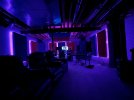I agree with michaeltonight above, bass is much harder to control. Here's some stuff I've learned over the years as I've done a lot of research on this and measured and built treatment for a few residential rooms:
Read all 4 pages of
this article. That covers monitor placement, room dimensions, symmetry, etc.
Once you have the monitors set up correctly, play pink noise or a song and walk around listening to the bass. The bass will be dramatically louder in the corners. Obviously fully treating the 4 walls would eliminate the bass problems in the corners but that is not doable in most residential rooms so it's more cost-effective to treat the corners with bass traps and the walls (& ceiling!) with broadband panels.
If you overdo it with thin insulation panels (i.e. 3-4") you'll absorb all the highs and just end up with a creepy/dead sounding room with massive peaks and nulls in the lower frequencies.
Put panels at the first reflection points on the walls and ceiling, as thick as you can make them, with as big an air gap as possible behind (not thicker than the panel itself tho). I used safe n' sound for these due to their higher gas flow resistivity and 2'x4'3" size so doubling them up results in 6" panels. Again, thicker is better so if you can do 9" then go for it. It takes almost the same labor to build thicker panels as thinner ones, so on the same budget go with fewer thicker panels vs. more thin panels. For the ceiling it's easier to just make one big panel for your cloud than to try to get several smaller panels aligned when hanging. If you have an unfinished basement for example with visible framing then you can turn the entire ceiling into a bass trap.
Put floor to ceiling traps in the corners as thick as you can make them, just copy
GIK's soffit bass trap design with 1x2's and R30 insulation. Good idea to make 2 for each corner and stack them vertically so you can move them in a normal sized car in the future. It's counter intuitive but at equivalent thicknesses material with lower gas flow resistivity (R30) absorbs lower frequencies better than higher gas flow resistivity (Safe n' Sound). You can verify this and the effectiveness of all your treatment with
this calculator (R30 is around 1650 Pa.s/m2, SnS is around 8000). The corners with 3 intersecting surfaces are the most important but bass traps can also be effective in the corners along the ceiling and even the corners where the walls meet the floor. Unlike with higher frequencies, you really can't have too much bass trapping so build as much as your budget allows.

